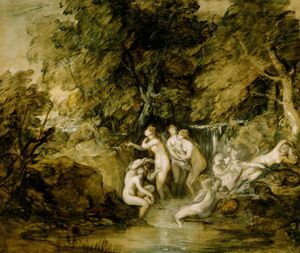To coincide with the start of the deerhunting season, today’s choice of picture is Thomas Gainsborough’s Diana and Actaeon. The painter took his theme from the Roman author Ovid’s Metamorphoses, which tells of how a hunter stumbled accidentally on the bathing place of Diana and her attendants, whereupon the goddess threw a handful of water in his face, turning him into a stag, to be tracked down and killed by his own dogs.
Gainsborough depicts the moment of Actaeon’s discovery and fateful transformation. The hunter, who kneels above a rocky outcrop, looking down on the nude goddess and her companions, still (just) retains his human form, but antlers have begun to sprout from his head. The theme of metamorphosis is daringly enhanced by the artist’s free, sketchy handling of paint. Looking at the picture is like looking at nature through half-closed eyes, shape-shifting and dream-like. The woodland bathing pool resembles a piece of secluded English scenery, a patch of Gainsborough’s native Suffolk transformed into the territory of myth. The cascading stream is rendered in just a few scratchy brushstrokes which, none the less, conjure up brilliantly the shimmer and flow of a waterfall. More glittering water can be seen running through the fingers of Diana’s outstretched right hand. Perhaps the artist imparted a special magic to his depiction of this substance in order to emphasise that water, in Ovid’s story, has magical properties. The spellbound Actaeon, splashed by Diana, has already become little more than a blur, barely distinct from the rocks and trees, a device which lyrically suggests his imminent death. The landscape has begun to reabsorb him.
Gainsborough painted Diana and Actaeon in about 1785, near the end of his own life. He was already suffering from the “swelled neck” he described in his last letters,...


